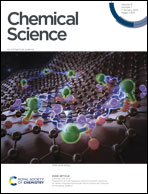New light on the imbroglio surrounding the C8H +6 isomers formed from ionized azulene and naphthalene using ion–molecule reactions†
Abstract
Most polycyclic aromatic hydrocarbons (PAHs) can isomerize with internal energies near to or below the dissociation threshold. The C10H+8 group of ions, made up of the naphthalene (Naph+) and the azulene (Azu+) radical cations, is a prototypical example. C8H+6 isomers are important species in the growth kinetics and formation of complex organic molecules, and more generally fragments from larger PAHs, yet information about C8H+6 structures is scarce and contradictory. Here, ion–molecule reactions were carried out and the tunable photoionization chemical monitoring technique was used to probe the C8H+6 isomers formed upon C2H2-loss from Naph+ and Azu+. The experimental findings were interpreted with the support of ab initio and kinetics calculations. To facilitate the interpretation of these data, chemical reactivity starting from phenylacetylene (PA) was studied. It was found that most of the C8H+6 ions formed from C10H8, in a timescale of 40 μs, are PA+ in the vicinity of the dissociation threshold. No evidence of the pentalene radical cation (PE+) was observed and explanations to reconcile previous results are presented.



 Please wait while we load your content...
Please wait while we load your content...